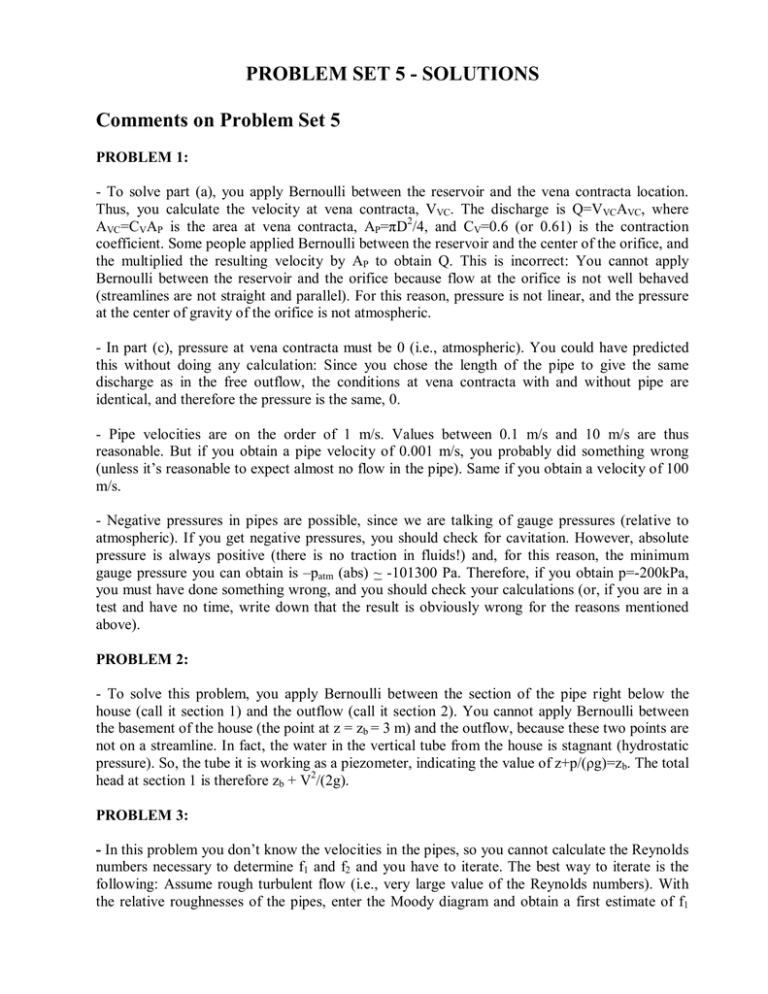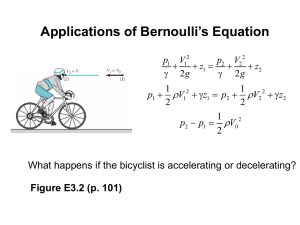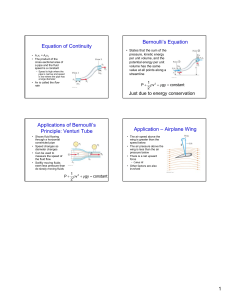PROBLEM SET 5 - SOLUTIONS Comments on Problem Set 5
advertisement

PROBLEM SET 5 - SOLUTIONS Comments on Problem Set 5 PROBLEM 1: - To solve part (a), you apply Bernoulli between the reservoir and the vena contracta location. Thus, you calculate the velocity at vena contracta, VVC. The discharge is Q=VVCAVC, where AVC=CVAP is the area at vena contracta, AP=πD2/4, and CV=0.6 (or 0.61) is the contraction coefficient. Some people applied Bernoulli between the reservoir and the center of the orifice, and the multiplied the resulting velocity by AP to obtain Q. This is incorrect: You cannot apply Bernoulli between the reservoir and the orifice because flow at the orifice is not well behaved (streamlines are not straight and parallel). For this reason, pressure is not linear, and the pressure at the center of gravity of the orifice is not atmospheric. - In part (c), pressure at vena contracta must be 0 (i.e., atmospheric). You could have predicted this without doing any calculation: Since you chose the length of the pipe to give the same discharge as in the free outflow, the conditions at vena contracta with and without pipe are identical, and therefore the pressure is the same, 0. - Pipe velocities are on the order of 1 m/s. Values between 0.1 m/s and 10 m/s are thus reasonable. But if you obtain a pipe velocity of 0.001 m/s, you probably did something wrong (unless it’s reasonable to expect almost no flow in the pipe). Same if you obtain a velocity of 100 m/s. - Negative pressures in pipes are possible, since we are talking of gauge pressures (relative to atmospheric). If you get negative pressures, you should check for cavitation. However, absolute pressure is always positive (there is no traction in fluids!) and, for this reason, the minimum gauge pressure you can obtain is –patm (abs) ~ -101300 Pa. Therefore, if you obtain p=-200kPa, you must have done something wrong, and you should check your calculations (or, if you are in a test and have no time, write down that the result is obviously wrong for the reasons mentioned above). PROBLEM 2: - To solve this problem, you apply Bernoulli between the section of the pipe right below the house (call it section 1) and the outflow (call it section 2). You cannot apply Bernoulli between the basement of the house (the point at z = zb = 3 m) and the outflow, because these two points are not on a streamline. In fact, the water in the vertical tube from the house is stagnant (hydrostatic pressure). So, the tube it is working as a piezometer, indicating the value of z+p/(ρg)=zb. The total head at section 1 is therefore zb + V2/(2g). PROBLEM 3: - In this problem you don’t know the velocities in the pipes, so you cannot calculate the Reynolds numbers necessary to determine f1 and f2 and you have to iterate. The best way to iterate is the following: Assume rough turbulent flow (i.e., very large value of the Reynolds numbers). With the relative roughnesses of the pipes, enter the Moody diagram and obtain a first estimate of f1 and f2. Now you can calculate V1 and V2. With this, you calculate the Reynolds numbers and, using the Moody diagram, you get new values of f1 and f2. And you keep doing this until your results converge. - The minor loss in a sudden expansion from a smaller to a larger conduit, such as point B, is given by (V1-V2)2/(2g). There is a graph in the book that gives the value of KL for this kind of expansion as a function of A1/A2. But who wants to use a graph when you have the exact analytical expression? (Particularly when the analytical expression is so simple as this one). Note that you can relate V1=4V2 by continuity, and the previous analytical expression gives you KL1 (to be multiplied by V12/(2g)) or KL2 (to be multiplied by V22/(2g)), as you prefer. - Please take a careful look of my plot of the EGL and the HGL, and make sure you understand how to draw them, including all the detail features (minor losses, velocity head at vena contracta, etc.)




